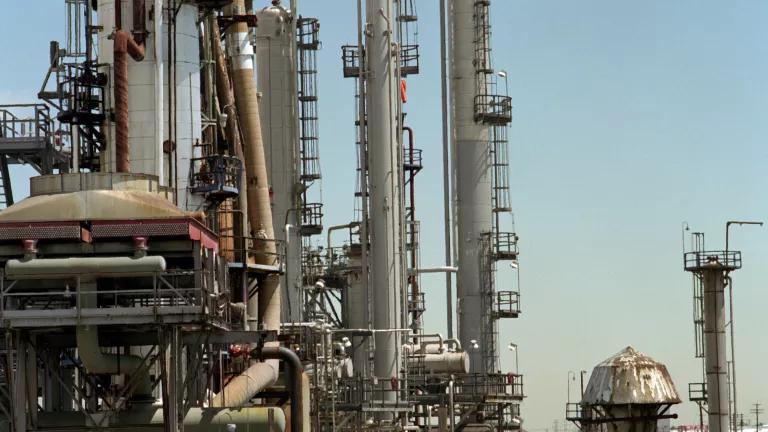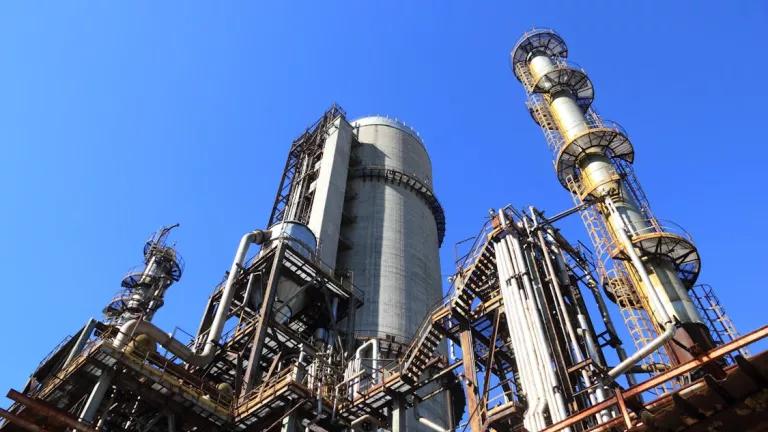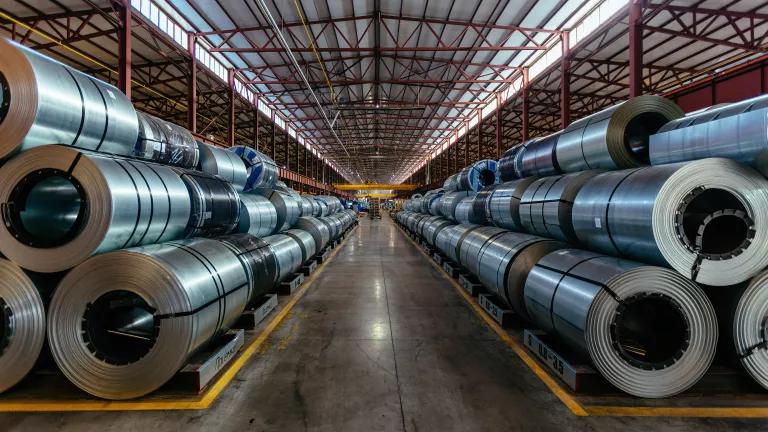Climate Bill Will Invest Big in Cleaning Up Heavy Industry
Governments around the world that are committed to climate action must have policies aimed specifically at decarbonizing the industrial sector. The Inflation Reduction Act of 2022 does exactly that.
Senate Democrats reached agreement on an historic budget reconciliation package calling for roughly $369 billion dollars in critical clean energy and climate justice investments. Included within that package are major investments to slash emissions at energy-intensive industrial facilities. That’s a big win for our climate and for the competitiveness of these vital domestic manufacturing sectors – Congress should pass it now.
The industrial sector produces many of the products and materials we rely on. It takes mined inputs like limestone, iron ore, and alumina and turns them into raw materials like cement, steel, and aluminum that are used elsewhere in the economy. The manufacturing processes by which many industrial materials are made require very high temperatures and very large amounts of energy. Today, these processes depend primarily on burning fossil fuels in applications that cannot be electrified. Further, a large proportion of the greenhouse gas (GHG) pollution in the sector is from process emissions from unavoidable chemical reactions necessary to produce goods from raw materials.
The result is that in the U.S., heavy industry is responsible for roughly one-quarter of economy-wide GHGs and that is expected to increase through 2050 -- the timeframe by when scientists tell us the global economy must achieve net-zero emissions if we are to avoid the worst consequences of climate change. Under business as usual, the industrial sector is on track to become the largest source of U.S. GHG emissions within the decade. At the same time, products like cement and steel are foundational to modern life and have few, if any, viable substitutes. Our societies will continue to rely on them for decades to come for everything from critical infrastructure like roads, schools, hospitals, and clean water to building wind turbines, solar panels, and electric vehicles to provide electricity and mobility in a carbon-constrained world.
Promptly decarbonizing heavy industry is therefore essential to meeting our climate goals. The U.S. and other governments around the world that are committed to climate action must have policies aimed specifically at decarbonizing the industrial sector. The Inflation Reduction Act of 2022 does exactly that.
A highlight of the package is that it combines billions in direct investments for deep decarbonization retrofits of large industrial facilities with billions for the federal government to purchase clean cement, steel and other industrial materials and thereby ensure that cleaner plants have a competitive advantage. Given the large share of U.S. emissions from the industrial sector and the challenges in retooling manufacturing facilities on short timeframes, these investments will be instrumental in enabling the U.S. to move closer towards meeting its climate targets.
Direct investments to decarbonize U.S. heavy industry.
The Advanced Industrial Facilities Deployment Program would invest nearly $6 billion to help the largest industrial emitters in the most emissions-intensive industrial sectors, like cement and steel plants, adopt the transformative technologies that can help them significantly slash their GHG pollution. These technologies include everything from major investments in energy efficiency upgrades, to transitioning currently non-electrified industrial processes to efficient, electric options, to installing carbon capture and storage at cement plants, which would capture CO2 emissions before they enter the atmosphere and store them permanently underground, to using green hydrogen – a carbon-free fuel made from water by using electricity generated from renewable source like solar and wind to split hydrogen molecules from oxygen molecules – to produce zero-emission steel. The program covers the full range of industrial emitting sectors and a mix of project sizes and technologies.
In parallel, the bill also expands advanced manufacturing tax credit (48C) eligibility to include industrial emissions reduction. The bill would provide this tax credit for industrial decarbonization projects that achieve at least a 20% emissions cuts. Our partners at the BlueGreen Alliance estimate that together these direct investments in industrial sector decarbonization could reduce up to 69 million metric tons of GHG pollution annually by 2030.
Low carbon materials transparency and procurement.
The climate package includes $250 million in grants to fund the creation of Environmental Product Declarations (EPDs) -- a best practice tool for capturing and communicating embodied emissions in final products, such as concrete or steel -- and $100 million in funding for low carbon materials labeling. This financial assistance will make it easy for manufacturers of all sizes to implement EPDs and help generate data critical to improving visibility into the lifecycle GHG emissions associated with a range of industrial products.
Critically, it also provides roughly $5.5 billion in funding allocations across multiple federal agencies to help procure low carbon industrial materials for transportation and building infrastructure projects, including the Government Services Administration, the Federal Highway Administration, the Department of Housing and Urban Development, the Department of Homeland Security, and the Federal Emergency Management Agency. Whether federal agencies are looking to construct high performance green buildings, rebuild a road or school after a natural disaster, launch a sustainable building pilot, make a community more climate resilient, or refurbish existing federal buildings, they should seek to do so using low carbon building materials. This funding from Congress would help make that possible.
As the federal government is one of the largest purchasers of cement, steel, and other common industrial building materials used in public works projects, federal procurement of low carbon materials can be a critical accelerator of industrial transformation, signaling a robust market for early adopters of incentives and decarbonization technologies. Our analysis also shows that funding low carbon materials procurement at levels similar to those in this bill has the potential to deliver tens of millions of tons of CO2 emissions savings. Federal procurement is maximally effective in driving CO2 emissions savings when paired with direct investments in industrial decarbonization – exactly as this bill does.
Beyond the funding detailed above, the bill also confers generous tax credits to clean hydrogen, defined as delivering at minimum a 60% reduction in lifecycle GHGs relative to today’s incumbent, unabated fossil hydrogen (or “grey” hydrogen). These tax credits are expected to provide a sea change in the hydrogen market and significantly boost near-term clean hydrogen production and deployment in the U.S.
Policymakers should continue to support policies and projects that prioritize zero-emissions, green hydrogen, which has primacy over other sources in terms of climate and public health integrity. Additionally, it will be vital for policymakers and stakeholders to pass policies and commit to targeting hydrogen deployment in its highest-value applications and avoid cannibalizing other more efficient climate solutions, where those are feasible (forthcoming NRDC blogs will delve deeper into this issue). In the industrial sector, clean hydrogen should be targeted towards replacing existing grey hydrogen uses in chemicals manufacturing and oil refining, in addition to replacing fossil fuels in the hardest-to-electrify industrial processes, such as steel manufacturing. On top of realizing the maximum carbon reductions, projects should be designed to minimize any adverse environmental or public health consequences for communities.
Given the long horizons for building and/or retrofitting industrial sites it is critical that U.S. policymakers advance policies now to jumpstart investments and plans. That’s exactly what this climate package would do, and we urge Congress to pass it without delay. Doing so will not only help tackle the climate crisis but support good jobs and clean air and strengthen the global competitiveness of our manufacturing base.


